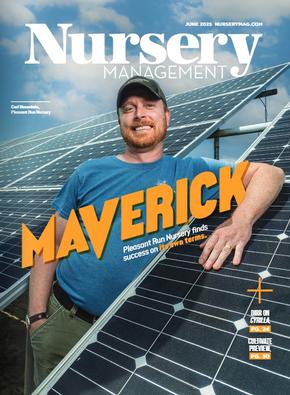Conservation in Crisis
Happy summer, folks! Blustering in on the back of an unexpected burst of heat, humidity, and storms, the fickle mistress that is the solstice has arrived. With it, the fluorescent blooms of Callirhoe involucrata take the stage along rocky borders, hardy tropical plants like Ensete maurelli and Musa basjoo begin less tentatively unfurling their leaves, and blazing stars (Liatris sp.) shoot for the balmy summer sky, promising tiny purple fireworks in the coming weeks. The rain and cool weather have allowed for a prosperous growing season, with perennials fuller and more lush than ever before, and fruiting shrubs and trees teeming with plentiful harvests for furred and feathered friends. Despite the confident beauty of the early summer and the feel-good vibes that it should instill, it is the aforementioned fauna that I’d like to speak of this week.
I was really hesitant to write about this particular topic, primarily because of the legality concerns I faced mid-situation, but the more I sat with it, the more important I felt it was. On Tuesday afternoon during my lunch break, I fatefully decided to go and get a treat at Starbucks because of a random $10 gift card I’d received for filling out a survey (thanks, Plantiful!) despite not having been to a Starbucks within recent memory. On my way there, and about five minutes from the nursery outside of Allentown Borough, I passed something that caught my eye and made me catch my breath. I was mid-voicemail with a close industry friend who probably could feel the reverberation of my shock on the other end: “Oh my god, I’m so sorry, I’m pretty sure that…. Was that a dead ******* bald eagle?!?!?” As I was grappling with the situation and trying to cohesively verbalize a voice message, I ultimately decided to turn around.
When I got back, there was another person pulled over (taking pictures, of course), and I goaded him into helping me get this magnificent creature into my car (yes, minimal brain cells were functioning at that moment, but it seemed very dead, so I was willing to take my chances). Sadly, this particular bird appeared to be struck by a vehicle, likely after being startled into flight while inspecting a deer carcass – something they only do if they’re feeling a bit lazy or don’t have better food sources available, but we’ll get to that in a bit. After about an hour of trying to locate the proper authorities to handle the situation, our feathered friend finally made it to Assunpink Wildlife Refuge here in Robbinsville, NJ.
(DISCLAIMER: As it turns out, it’s wildly illegal to transport a bald eagle of any type, alive or dead, unless given permission by the proper authorities to do so. Whoops.)
Here’s why I’m writing this article this week.
That particular bald eagle, one of only two that lived within the Allentown area and was part of a nesting couple, was a major concern for the local residents who petitioned and protested against land clearing and development of yet another warehouse. Of course, callous human interests won over nature’s needs, so the clearing of a previously manmade lake and surrounding woodlands was swiftly undertaken, somewhat curiously, around the perimeter of the local USDA and APHIS facilities. Don’t worry, the irony is not lost on me.
I guess the point of writing this, as an ecologically conscious individual that is part of an even larger ecological community, is to both share my dismay and to advocate for the conservation of your local lands before destructive habitat loss, like the loss of our local woodlands, destroys whatever sacred parts of nature we have left. Sure, maybe this particular eagle was feeling a bit lazy that day, and didn’t feel like hunting. More than likely, its resources have diminished exponentially, leaving it desperate to sustain itself in a once thriving sylvan paradise, but because of its own loss, the loss of whispering trees and the pattering of small, tasty animals exploring the leaf litter below, the loss of a suitable habitat to raise young and ensure their survival, we are left to deal with the loss of a national treasure. And that’s a real shame.
Please advocate for your local lands. Join a land trust. Volunteer for conservation advocacy groups. Plant trees anywhere and as often as you can. Help to take nature back not for yourself, not for your clients, not to go viral on Instagram, but for the flora and fauna that so desperately need our intervention.
Bald eagles typically prefer coniferous trees, like pines and spruces, but will also utilize hickories, cottonwoods, and our native oaks.
If you want to design for eagle conservation, start here:
Quercus alba | white oak | (19) #15’s available
Quercus bicolor | swamp white oak | (27) #20’s available
Quercus palustris | pin oak | (9) #15’s and (16) #20’s available
Quercus phellos | willow oak | (15) #15’s available
Quercus rubra | red oak | (27) #20’s available
Visit the Land Trust Alliance website to locate conservation organizations in your area by clicking here.
In lighter news, our beloved, treasured, and fearless leader, Carl Hesselein, was interviewed by the folks over at Nursery Management Magazine. If you think that we haven’t heard endless Top Gun references for the last week, you’d be terribly wrong.
You can read the whole article by clicking HERE.
Finally, we’ve now added the Julian Calendar to our Grower’s Comments! To make things easier for you (and so that we’re all on the same timeline together), you can now see when Growers Comments were added to make sure you’re on top of all the best (or not-so-good) goings-on of the plants at Pleasant Run.
Don’t see a Grower’s Comment? No worries! That just means things are going as expected and there’s nothing special to report.


